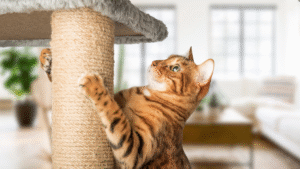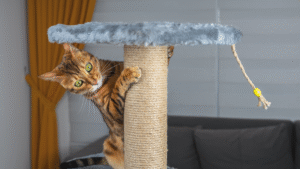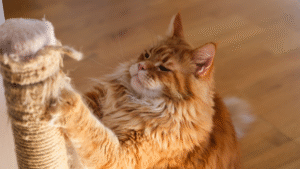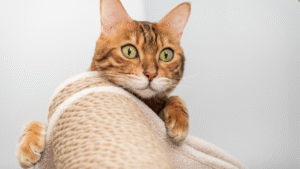Have you ever come home to the sad sight of your favorite couch shredded to pieces or a new chair covered in claw marks? You’re not alone.
Scratching is one of the most common (and frustrating) behaviors cat owners face. But don’t despair — or reach for drastic measures just yet.
There are natural, safe, and effective ways to stop your cat from scratching furniture without harming them or your home.

Why Do Cats Scratch Furniture?
Before we can teach our cats to stop scratching furniture, we first need to understand why they do it. Scratching is an instinctive and vital part of feline behavior, serving several important purposes:
1. Marking Territory
Cats have scent glands in their paws, so when they scratch, they leave both a scent and a visual mark. This is their way of claiming territory and communicating with other animals.
2. Claw Maintenance
Scratching helps cats remove the outer sheath of their claws, keeping them sharp and healthy. It’s the feline equivalent of nail trimming for humans.
3. Stretching and Exercise
When cats scratch, they stretch their muscles — especially in their shoulders and backs. Think of it as their version of yoga. It feels good and keeps them limber.
4. Stress Relief and Stimulation
Scratching also serves as an emotional outlet. Cats scratch when they’re stressed, bored, or overexcited. It’s their way of releasing pent-up energy and tension.
Once you understand these motivations, the solution becomes clear: you can’t stop your cat from scratching entirely — but you can teach them where and when to do it appropriately.
Declawing Is Not the Answer
Some cat owners consider declawing as a solution to furniture scratching, but this is both cruel and outdated. Declawing should never be an option unless it’s medically necessary for the cat’s health.
Declawing is not just nail trimming — it’s a surgical amputation of the last bone in each toe. (It’s like cutting off your fingers at the first knuckle.) It’s painful, and it can lead to lifelong complications such as:
-
Chronic pain and lameness
-
Behavioral problems (biting, aggression, litter box avoidance)
-
Mobility and balance issues
-
Joint and arthritis problems later in life
Many countries — and several U.S. states and cities — have banned declawing for these reasons.
The good news? There are far kinder and more effective ways to stop your cat from scratching furniture.

Step 1: Provide Alternatives
Your cat isn’t being “bad” when they scratch the couch — they simply don’t have a better option. You need to provide that alternative.
1. Choose the Right Scratching Post
Scratching posts come in a variety of materials and styles. Cats have individual preferences, so experiment to see what your cat likes best. Do they prefer scratching upright or on flat surfaces?
Popular options include:
-
Sisal rope or fabric posts – durable and satisfying texture for most cats.
-
Cardboard scratchers – inexpensive and popular, though they may need frequent replacement.
-
Carpeted posts – effective but can confuse cats if your floors are also carpeted.
-
Wooden scratchers – mimic natural bark, appealing to cats with outdoor instincts.
2. Make It Stable
A wobbly post is useless. Ensure the scratching post is sturdy and tall enough for your cat to stretch fully. A good rule of thumb: the post should be at least as tall as your cat when they stand on their hind legs.
3. Offer Multiple Scratching Areas
If you live in a large home or have multiple cats, provide several scratching zones. Think of them as designated “scratching stations” spread throughout your space.

Step 2: Place the Scratchers Strategically
Even the best scratching post won’t help if it’s hidden in a corner your cat never visits. Cats scratch in specific spots for a reason — so you’ll need to place the posts wisely.
-
Near the furniture they’re currently scratching: Cats tend to return to the same spot. Put a post right next to their favorite scratching area.
-
Near their sleeping areas: Cats often stretch and scratch right after waking up.
-
In visible areas: Scratching is a territorial behavior. If they can’t see the post, it’s less appealing.
Once your cat starts using the post regularly, you can slowly move it to a more convenient location.
Step 3: Discourage Furniture Scratching
While encouraging positive scratching habits, you also want to make your furniture less appealing.
1. Use Scratch Guards
Try furniture protectors, double-sided tape, or vinyl sheets on the affected areas. Cats dislike sticky textures and will quickly lose interest in scratching those spots.
2. Use Deterrent Scents
Cats have a keen sense of smell. Lightly spray your furniture with a citrus, lavender, or apple cider vinegar solution (always test first to prevent damage). You can also use cat-safe commercial deterrent sprays.
3. Cover or Rearrange Furniture
If your cat targets one specific piece, cover it temporarily with a throw blanket or rearrange the room so they can’t access it easily. Sometimes, a small environmental change can break the habit.
4. Trim Their Claws
Regular claw trimming won’t eliminate scratching but will minimize the damage. Trim your cat’s nails every two to three weeks. If your cat resists, try short, calm sessions with plenty of treats and praise.
Step 4: Reward and Redirect
Positive reinforcement is the key to changing your cat’s behavior. Punishment — like yelling, spraying water, or hitting — only increases fear and anxiety.
Instead:
-
Reward your cat immediately when they use the scratching post with treats, praise, or playtime.
-
Encourage interest by rubbing catnip or silvervine on the post.
-
Play near the scratching post so your cat naturally interacts with it.
Consistency and timing are crucial. Your cat needs to associate the post with positive experiences.

Step 5: Identify Other Reasons for Scratching
Sometimes, excessive scratching can be a symptom of emotional or environmental issues.
1. Boredom
Bored cats act out. Provide enrichment with climbing trees, puzzle feeders, and interactive toys. Dedicate at least 15 minutes a day to active play.
2. Disrupted Routine
Cats are creatures of habit. Sudden changes — like moving homes, new pets, or altered feeding times — can trigger anxiety and unwanted scratching. Try to maintain a consistent routine.
3. Lack of Safe Spaces
Cats need secure, elevated resting spots where they can retreat and feel safe. Add cozy beds, cat trees, or window perches to give them a sense of security.
Step 6: Use Pheromone Products
If your cat scratches due to stress or territorial behavior, pheromone sprays or diffusers (such as Feliway) can help. These mimic natural feline calming scents and reduce anxiety-driven scratching.
Place a diffuser near areas your cat scratches most often. You can also lightly spray pheromone solutions on beds, furniture, or scratching posts.
Step 7: Be Patient and Consistent
Stopping your cat from scratching furniture takes time, consistency, and patience. Don’t expect instant results — habits form over weeks, not days.
With persistence and positive reinforcement, most cats can be trained within a few weeks to a couple of months.

Common Mistakes to Avoid
-
Declawing – never humane or necessary.
-
Punishment – yelling or hitting only increases fear.
-
Using one post – variety and proper placement are essential.
-
Ignoring the root cause – scratching can signal stress or boredom.
-
Expecting instant change – patience and consistency are vital.
Final Words
Your cat’s scratching doesn’t have to mean the end of your furniture. With the right combination of understanding, training, and environmental adjustments, you can protect your home and keep your cat content.
Provide stable, appealing scratching posts, protect your furniture with temporary deterrents, and reward good behavior. Stay consistent and patient — soon, your cat will prefer their scratching posts over your couch.
- Homemade Calming Spray To Help Dogs During Training - November 12, 2025
- 7 DIY Dog Training Tools You Can Make From Household Items - November 12, 2025
- How To Make Your Own Clicker For Dog Training - November 12, 2025
